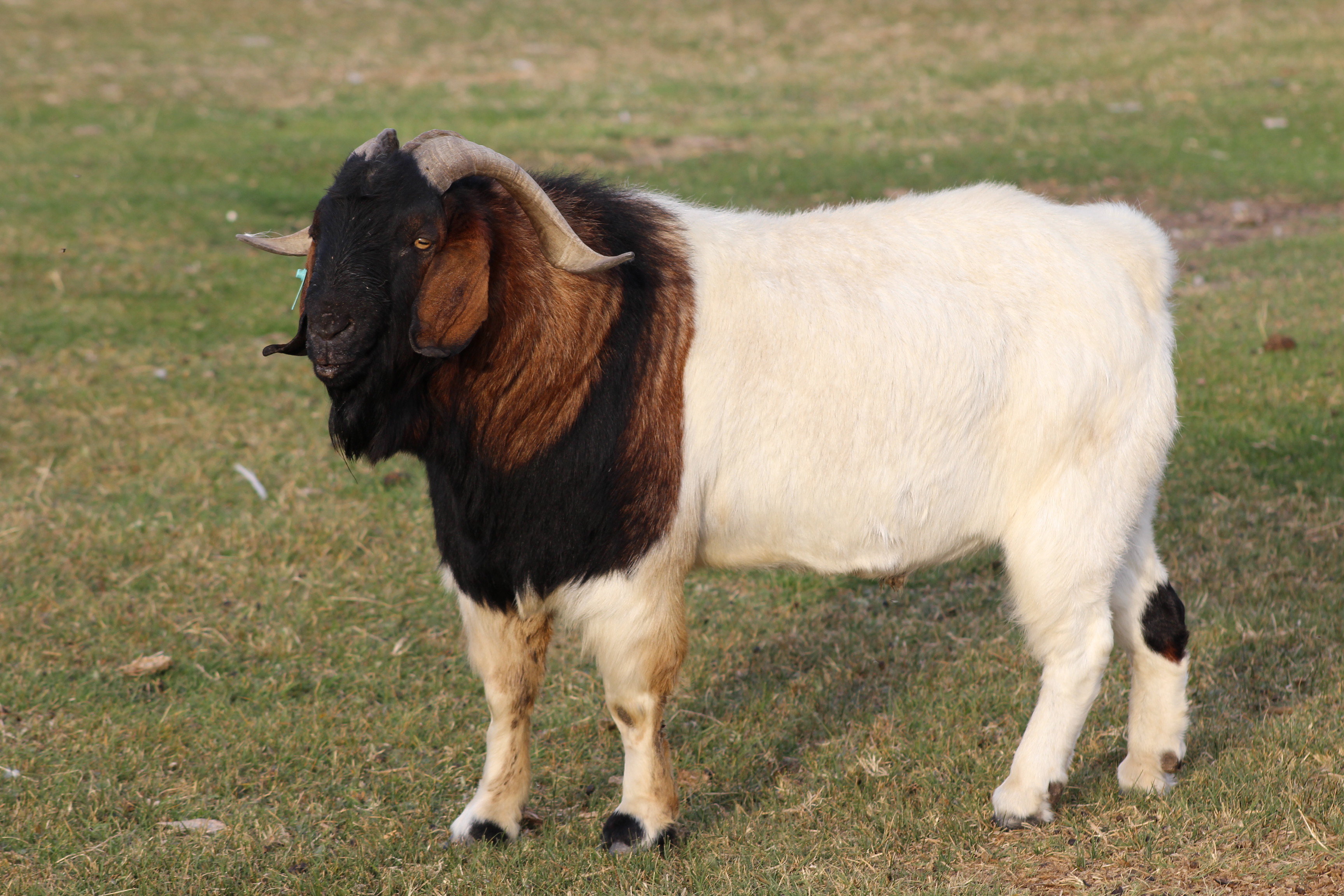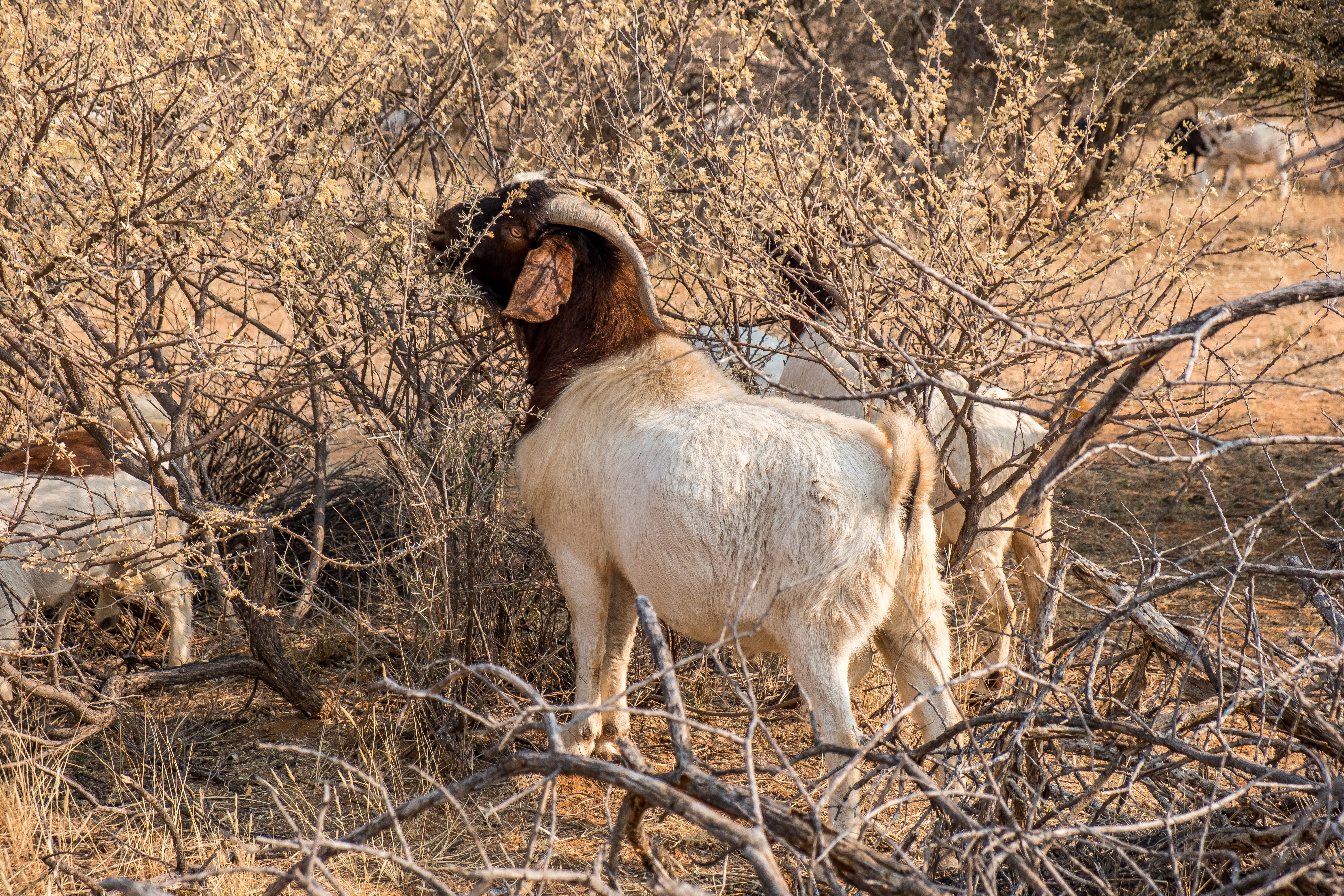Boer Goat on:
[Wikipedia]
[Google]
[Amazon]

 The Boer or Boerbok is a South African
The Boer or Boerbok is a South African
 Due to their versatility on different terrains, Boer goat are frequently used for land maintenance, especially to prevent
Due to their versatility on different terrains, Boer goat are frequently used for land maintenance, especially to prevent
List of breeds documented in the Global Databank for Animal Genetic Resources
annex t
''The State of the World's Animal Genetic Resources for Food and Agriculture''
Rome: Commission on Genetic Resources for Food and Agriculture, Food and Agriculture Organization of the United Nations. {{ISBN, 9789251057629. Archived 23 June 2020. Valerie Porter, Lawrence Alderson, Stephen J.G. Hall, D. Phillip Sponenberg (2016)
''Mason's World Encyclopedia of Livestock Breeds and Breeding''
(sixth edition). Wallingford: CABI. {{ISBN, 9781780647944. Breed data sheet: Boer / South Africa (Goat)
Domestic Animal Diversity Information System of the Food and Agriculture Organization of the United Nations. Accessed April 2022. Transboundary breed: Boer
Domestic Animal Diversity Information System of the Food and Agriculture Organization of the United Nations. Accessed April 2022. Osman Mahgoub, I.T. Kadim, E.C. Webb (2012). ''Goat Meat Production and Quality''. Wallingford: CABI. {{isbn, 9781845938499. Goat breeds Meat goat breeds Goat breeds originating in South Africa

 The Boer or Boerbok is a South African
The Boer or Boerbok is a South African breed
A breed is a specific group of domestic animals having homogeneous appearance (phenotype), homogeneous behavior, and/or other characteristics that distinguish it from other organisms of the same species. In literature, there exist several slig ...
of meat goat
The goat or domestic goat (''Capra hircus'') is a domesticated species of goat-antelope typically kept as livestock. It was domesticated from the wild goat (''C. aegagrus'') of Southwest Asia and Eastern Europe. The goat is a member of the a ...
. It was selectively bred
Selective breeding (also called artificial selection) is the process by which humans use animal breeding and plant breeding to selectively develop particular phenotypic traits (characteristics) by choosing which typically animal or plant mal ...
in the Eastern Cape
The Eastern Cape is one of the provinces of South Africa. Its capital is Bhisho, but its two largest cities are East London and Gqeberha.
The second largest province in the country (at 168,966 km2) after Northern Cape, it was formed in ...
from about 1920 for meat qualities and for the ability to survive by grazing on the thorn veldt of that region. It has been exported to many countries, and has been used to improve the meat qualities of other breeds.
History
The Boer goat was bred from the indigenous South African goats kept by the Namaqua, San, and Fooku tribes, with some crossing of Indian and Europeanbloodline
Heredity, also called inheritance or biological inheritance, is the passing on of traits from parents to their offspring; either through asexual reproduction or sexual reproduction, the offspring cells or organisms acquire the genetic inform ...
s being possible. They were selected for meat
Meat is animal flesh that is eaten as food. Humans have hunted, farmed, and scavenged animals for meat since prehistoric times. The establishment of settlements in the Neolithic Revolution allowed the domestication of animals such as chic ...
rather than milk
Milk is a white liquid food produced by the mammary glands of mammals. It is the primary source of nutrition for young mammals (including breastfed human infants) before they are able to digestion, digest solid food. Immune factors and immune ...
production; due to selective breeding
Selective breeding (also called artificial selection) is the process by which humans use animal breeding and plant breeding to selectively develop particular phenotypic traits (characteristics) by choosing which typically animal or plant mal ...
and improvement, the Boer goat has a fast growth rate and excellent carcass qualities, making it one of the most popular breeds of meat goat in the world. Boer goats have a high resistance to disease and adapt well to hot, dry semideserts.
Characteristics
Boer goats commonly have white bodies and distinctive brown heads. Some Boer goats can be completely brown or white or paint, which means large spots of a different color are on their bodies. Like theNubian goat
The Anglo-Nubian is a British breed of domestic goat. It originated in the nineteenth century from cross-breeding between native British goats and a mixed population of large lop-eared goats imported from India, the Middle East and North Afr ...
, they possess long, pendulous ears. They are noted for being docile, fast-growing, and having high fertility rates. Does are reported to have superior mothering skills as compared to other breeds.
Boer goats tend to gain weight at about the same rate as their sire, so a buck from a proven fast-growing bloodline
Heredity, also called inheritance or biological inheritance, is the passing on of traits from parents to their offspring; either through asexual reproduction or sexual reproduction, the offspring cells or organisms acquire the genetic inform ...
will command the highest price, as its offspring tend to also be fast growers. The primary market for slaughter goats is a kid
Kid, Kids, KIDS, and K.I.D.S. may refer to:
Common meanings
* Colloquial term for a child or other young person
** Also for a parent's offspring regardless of age
* Engage in joking
* Young goats
* The goat meat of young goats
* Kidskin, lea ...
; kids should reach marketable size at weaning age. The kid of a proven fast-growing sire might weigh at 90 days, while the kid of a poor-quality sire might weigh only at 90 days. An average-quality buck will initially be less expensive to purchase, but it can significantly undermine an operation's long-term profitability
In economics, profit is the difference between the revenue that an economic entity has received from its outputs and the total cost of its inputs. It is equal to total revenue minus total cost, including both explicit and implicit costs.
It i ...
.
Use
 Due to their versatility on different terrains, Boer goat are frequently used for land maintenance, especially to prevent
Due to their versatility on different terrains, Boer goat are frequently used for land maintenance, especially to prevent bush encroachment
Woody plant encroachment (also called bush encroachment, shrub encroachment, woody encroachment, bush thickening, or woody plant proliferation) is a natural phenomenon characterised by the increase in density of woody plants, bushes and shrubs, ...
on rangeland
Rangelands are grasslands, shrublands, woodlands, wetlands, and deserts that are grazed by domestic livestock or wild animals. Types of rangelands include tallgrass and shortgrass prairies, desert grasslands and shrublands, woodlands, savannas ...
. As typical browsers, the goats are able to suppress re-growth after bush thinning and to browse from plants up to 1.8 meters high, standings on their hind legs.
Boer goats are polyestrous
The estrous cycle (, originally ) is the set of recurring physiological changes that are induced by reproductive hormones in most mammalian therian females. Estrous cycles start after sexual maturity in females and are interrupted by anestrous ...
(they can breed throughout the year), and they reach sexual maturity
Sexual maturity is the capability of an organism to reproduce. In humans it might be considered synonymous with adulthood, but here puberty is the name for the process of biological sexual maturation, while adulthood is based on cultural definitio ...
at five months of age. A typical breeding program is to produce three kid crops every two years, meaning the does are pregnant for five months, nurse their kids for three months, and then are rebred. Multiple births are common, and a 200% kid crop is achievable in managed herds. Usually, first-time does have one kid, but they may have more. After that, they usually have two kids every other breeding. The kids can be brown, black, white, or mixed.
Common crosses are Boer x Spanish goat
The Spanish goat, also called the brush goat or scrub goat, came originally from Spain via Mexico to the USA. It is now a meat and brush-clearing type found widely in the United States. In the Southeast and elsewhere, they are often referred to as ...
, Boer x Angora goat
Angora may refer to:
Places
*Angora, the historic name of Ankara, the capital city of Turkey
*Angora, Philadelphia
** Angora (SEPTA station), a commuter rail station
* Angora, Minnesota
* Angora Township, Minnesota
*Angora, Nebraska
*Angora Lak ...
, Boer x Kiko goat
The Kiko is a breed of meat goat originating from New Zealand. ''Kiko'' comes from the Māori word for meat. The Kiko breed was developed in the 1980s by Garrick and Anne Batten, who cross-bred local feral goats with imported dairy goat bucks ...
, Boer x Nubian goat
The Anglo-Nubian is a British breed of domestic goat. It originated in the nineteenth century from cross-breeding between native British goats and a mixed population of large lop-eared goats imported from India, the Middle East and North Afr ...
, Boer x Sirohi
Sirohi is a city, located in Sirohi district in southern Rajasthan state in western India. It is the administrative headquarters of Sirohi District and was formerly the capital of the princely state of Sirohi ruled by Deora Chauhan Rajput rul ...
, Boer x Osmanabadi, and Boer x Jamnapari goat
Jamnapari or Jamunapari is an Indian breed of domestic goat originating in Uttar Pradesh. It has exported to Indonesia, where it is known as the Etawah. It is bred for both milk and meat. The name is derived from the Yamuna river.
History
...
. An effort to crossbreed with the Malabari goat
Malabari goats are bred in Malabar district of Kerala
Kerala ( ; ) is a state on the Malabar Coast of India. It was formed on 1 November 1956, following the passage of the States Reorganisation Act, by combining Malayalam-speaking regio ...
has been controversial.
They may also be bred for show.Bowman, Gail, Raising Meat Goats for Profit 0967038103
References
{{reflist, refs= Barbara Rischkowsky, Dafydd Pilling (editors) (2007)List of breeds documented in the Global Databank for Animal Genetic Resources
annex t
''The State of the World's Animal Genetic Resources for Food and Agriculture''
Rome: Commission on Genetic Resources for Food and Agriculture, Food and Agriculture Organization of the United Nations. {{ISBN, 9789251057629. Archived 23 June 2020. Valerie Porter, Lawrence Alderson, Stephen J.G. Hall, D. Phillip Sponenberg (2016)
''Mason's World Encyclopedia of Livestock Breeds and Breeding''
(sixth edition). Wallingford: CABI. {{ISBN, 9781780647944. Breed data sheet: Boer / South Africa (Goat)
Domestic Animal Diversity Information System of the Food and Agriculture Organization of the United Nations. Accessed April 2022. Transboundary breed: Boer
Domestic Animal Diversity Information System of the Food and Agriculture Organization of the United Nations. Accessed April 2022. Osman Mahgoub, I.T. Kadim, E.C. Webb (2012). ''Goat Meat Production and Quality''. Wallingford: CABI. {{isbn, 9781845938499. Goat breeds Meat goat breeds Goat breeds originating in South Africa